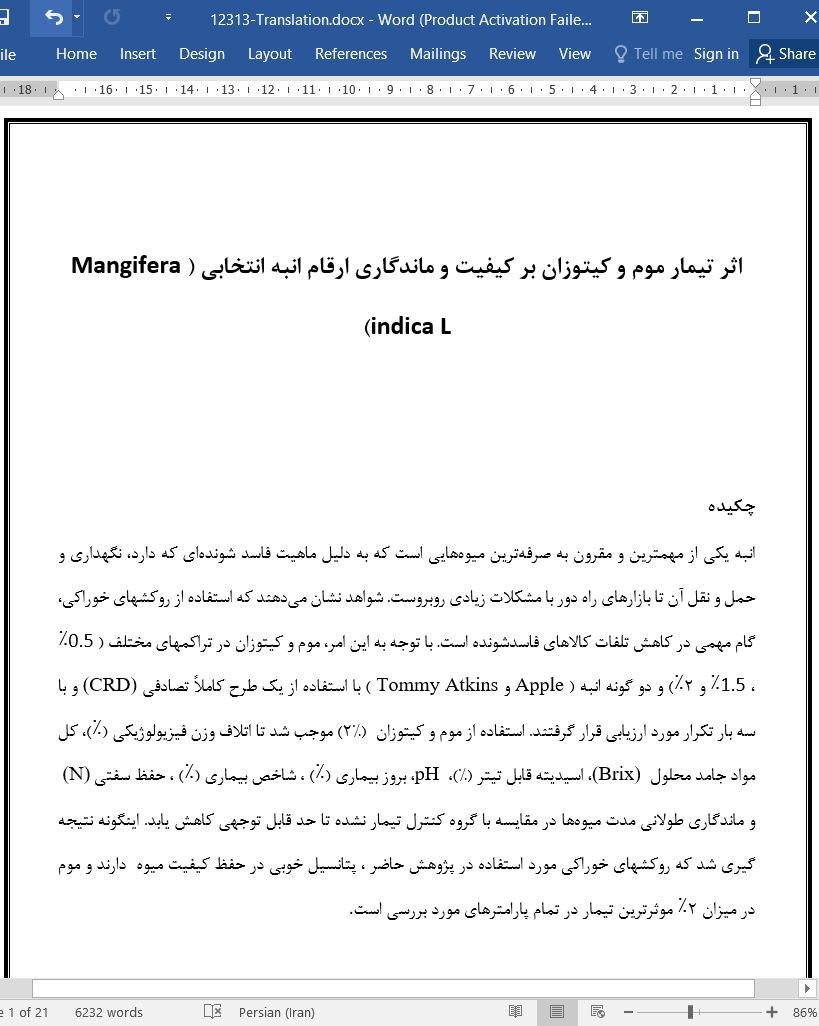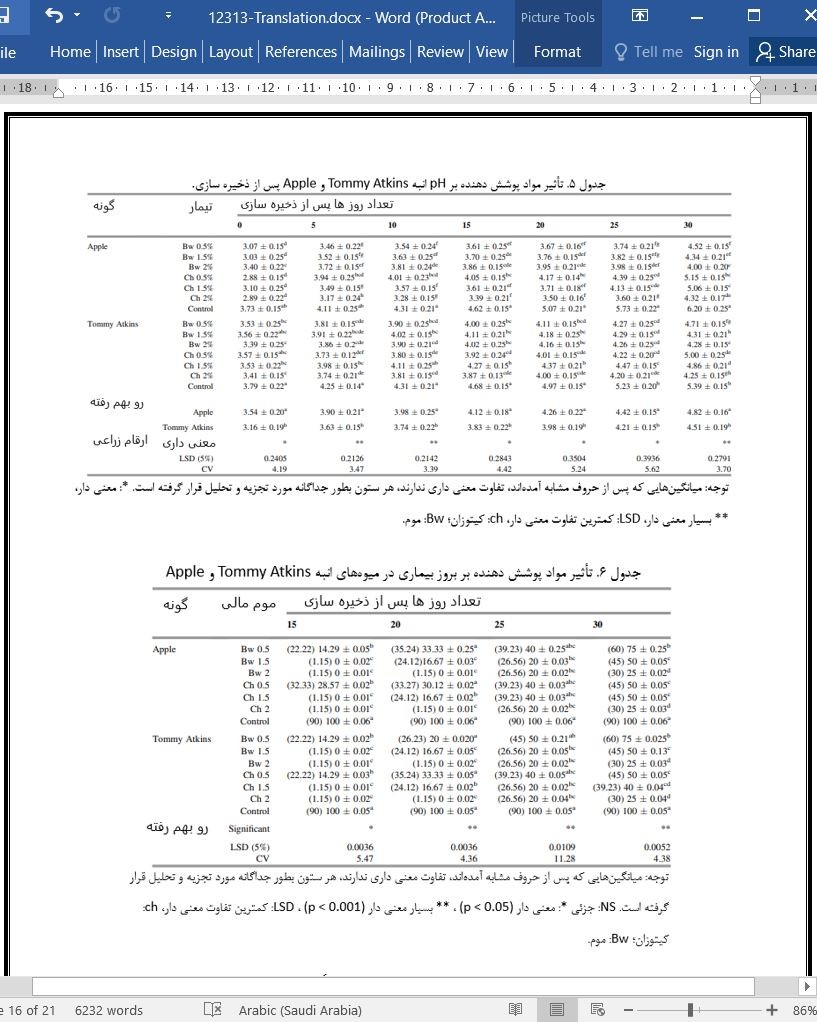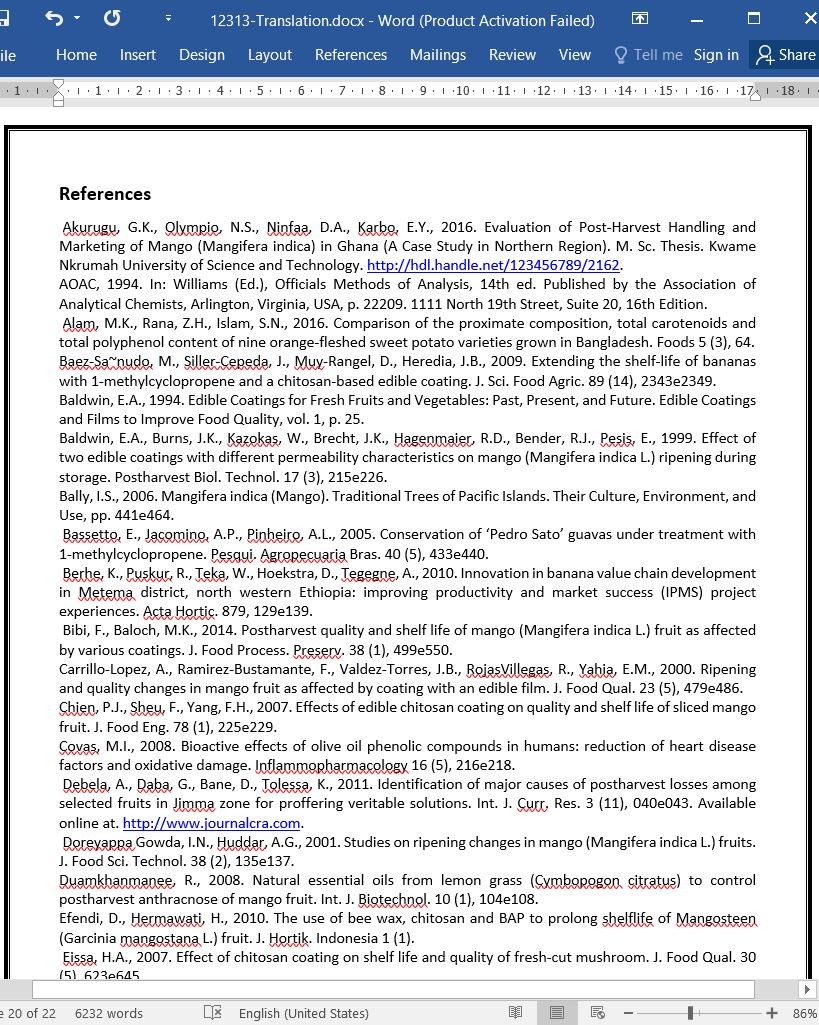
اثر تیمار موم و کیتوزان بر کیفیت و ماندگاری ارقام انبه انتخابی (Mangifera indica L)
چکیده
انبه یکی از مهمترین و مقرون به صرفهترین میوههایی است که به دلیل ماهیت فاسد شوندهای که دارد، نگهداری و حمل و نقل آن تا بازارهای راه دور با مشکلات زیادی روبروست. شواهد نشان میدهند که استفاده از روکشهای خوراکی، گام مهمی در کاهش تلفات کالاهای فاسدشونده است. با توجه به این امر، موم و کیتوزان در تراکمهای مختلف ( 0.5٪ ، 1.5٪ و 2٪) و دو گونه انبه (Apple و Tommy Atkins) با استفاده از یک طرح كاملاً تصادفي (CRD) و با سه بار تكرار مورد ارزيابي قرار گرفتند. استفاده از موم و کیتوزان (2%) موجب شد تا اتلاف وزن فیزیولوژیکی (٪)، کل مواد جامد محلول (Brix) ، اسیدیته قابل تیتر (%)، pH ، بروز بیماری (٪) ، شاخص بیماری (٪) ، حفظ سفتی (N) و ماندگاری طولانی مدت میوهها در مقایسه با گروه کنترل تیمار نشده تا حد قابل توجهی کاهش یابد. اینگونه نتیجه گیری شد که روکشهای خوراکی مورد استفاده در پژوهش حاضر ، پتانسیل خوبی در حفظ کیفیت میوه دارند و موم در میزان 2٪ موثرترین تیمار در تمام پارامترهای مورد بررسی است.
1. مقدمه
انبه (Mangifera indica L.) به عنوان یک میوه صادراتی گرمسیری نوظهور در بیش از 90 کشور در سراسر جهان تولید میشود و میزان تولید آن بیش از 28.51 میلیون تن متریک میباشد (Akurugu همکاران 2016). تقریباً 77٪ از تولید جهانی انبه به آسیا تعلق دارد. آمریکا و آفریقا به ترتیب حدود 13٪ و 10٪ را به خود اختصاص میدهند (Kummu و همکاران، 2012). اتیوپی دارای اکولوژی زراعی متنوعی است که میتواند محصولات مختلف میوه و همچنین انبه را با پتانسیل عظیمی پرورش دهد (Berhe و همکاران، 2010). بیش از 47 هزار هکتار زمین در اتیوپی تحت کشت محصولات میوه قرار دارد و و انبه 12.61 درصد از سطح زیر کشت محصولات میوه را شامل میشود (Yeshitela و Nessel، 2003).
4. نتیجه گیری
در تلاش برای حفظ تازگی و ماندگاری میوه انبه، پوششهای خوراکی در غلظتهای مختلف مورد بررسی قرار گرفتند و در مقایسه با گروه کنترل تیمار نشده پتانسیل بالایی را در حفظ کیفیت کلی نشان دادند. این مطالعه نشان داد که روکش موم و کیتوزان به طور موثری رسیدن میوههای انبه Apple و Tommy Atkins را به تأخیر انداخت که این امر در کاهش اتلاف وزن و حفظ سفتی آنها مشهود بود. علاوه براین، در میوههای انبه در مقایسه با گروه کنترل، استفاده از روکش موم و کیتوزان تا حد قابل توجهی از تغییر در TA و TSS جلوگیری کرد. هر دو روکش خوراکی با غلظتهای مختلف نه تنها تازگی میوهها را در طی سه هفته اول ذخیره سازی حفظ کرد، بلکه بروز بیماری را نیز کنترل کرد. اگرچه، هر روکش تأثیر خودش را بر کیفیت و ماندگاری میوهها داشت، اما موم 2٪ از نظر حفظ تازگی و کنترل بروز بیماری نسبت به تیمارهای دیگر برتری داشت. بنابراین، رسیدگی کنندگان این امر میتوانند به آسانی این فن آوری را اتخاذ کنند تا انبههای تازه را با نوع مناسبی از پوشش و غلظت موم تیمار کرده و برای حمل و نقل مسافتهای طولانی بدون تاثیرگذاری بر کیفیت میوهها آماده نمایند.
Abstract
Mango is one of the most economically important fruit facing greater problems in storage and transportation to long distance market because of its perishable nature. Evidence suggested that application of edible coatings is a key step to reduce loss of perishable commodities. In line with this, Beeswax and chitosan at different concentrations (0.5%, 1.5% and 2%), and two mango varieties (Apple and Tommy Atkins) were evaluated using completely randomized design (CRD) in three replications. Application of beeswax and chitosan at (2%) significantly reduced physiological weight loss (%), total soluble solid (°Brix), titratable acidity (%), pH, disease incidence (%), disease index (%), maintained Firmness (N) and prolonged shelf-life of fruits compared with untreated control. It was concluded that edible coatings used in the present study have a good potential in maintaining the fruit quality and beeswax at 2% being the most effective treatment on all parameters tested.
1. Introduction
Mango (Mangifera indica L.) as an emerging tropical export fruit is produced in over 90 countries worldwide with a production of over 28.51 million metric tons (Akurugu et al., 2016). Asia accounts for approximately 77% of global mango production. America and Africa account for approximately 13% and 10%, respectively (Kummu et al., 2012). Ethiopia has a diverse agro-ecology that can grow various fruit crops with a huge potential for mango production as well (Berhe et al., 2010). More than 47 thousand hectares of land is under fruit crops in Ethiopia and mangoes cover 12.61% of the fruit crop area (Yeshitela and Nessel, 2003).
4. Conclusions
In an effort to maintain the freshness and shelf-life of mango fruits, edible coating at different concentration were tested and demonstrated great potential to be used in maintaining the overall quality compared with untreated control. The study indicated that beeswax and chitosan coating effectively delayed ripening of both ‘Apple’ and ‘Tommy Atkins’ mango fruits as indicated by reduction of weight loss, the retention of firmness. Furthermore, the change in TA and TSS in the mango fruits were significantly inhibited by the beeswax and chitosan coating compared with untreated control. Both edible coatings with different concentrations not only maintained the freshness of the fruits during first three weeks of storage but also controlledthe occurrence of disease. Although every coating has its impact on the quality and shelf life of the fruits beeswax at 2% outweighs other treatments in terms of maintaining the freshness and controlling the occurrence of disease. Therefore, mango handlers could easily adapt the technology to treat fresh mangoes in order to transport to long distance without affecting its quality if treated carefully with appropriate type of wax coat and concentration.
چکیده
1. مقدمه
2. مواد و روشها
2.1. جمع آوری مواد آزمایشی
2.2 آماده سازی مواد آزمایشی
2.3 طراحی آزمایشی و کاربرد درمانی
2.4 دادههای جمع آوری شده
2.4.1 درصد اتلاف وزن
2.4.2 سفتی
2.4.3 مجموع مواد جامد محلول
2.4.4 اسیدیته قابل تیتر و PH
2.4.5 بروز بیماری
2.4.6 شدت بیماری
2.4.7 عمر نگهداری
2.5 تحلیل آماری
3 نتایج و بحث
3.1 درصد اتلاف وزن
3.2 سفتی
3.3 کل مواد جامد محلول
3.4 اسیدیته قابل تیتر و PH
3.5 بروز بیماری
3.6 شدت بیماری
3.7 عمر نگهداری
4نتیجه گیری
منابع
Abstract
1. Introduction
2. Materials and methods
2.1. Experimental materials collection
2.2. Experimental materials preparation
2.3. Experimental design and treatment application
2.4. Data collected
2.4.1. Percentage weight loss
2.4.2. Firmness
2.4.3. Total soluble solids
2.4.4. Titratable acidity and pH
2.4.5. Disease incidence
2.4.6. Disease severity
2.4.7. Storage-life
2.5. Statistical analysis
3. Results and discussion
3.1. Percent weight loss
3.2. Firmness
3.3. Total soluble solids
3.4. Titratable acidity and pH
3.5. Disease incidence
3.6. Disease severity
3.7. Storage life
4. Conclusions
References
- اصل مقاله انگلیسی با فرمت ورد (word) با قابلیت ویرایش
- ترجمه فارسی مقاله با فرمت ورد (word) با قابلیت ویرایش، بدون آرم سایت ای ترجمه
- ترجمه فارسی مقاله با فرمت pdf، بدون آرم سایت ای ترجمه



